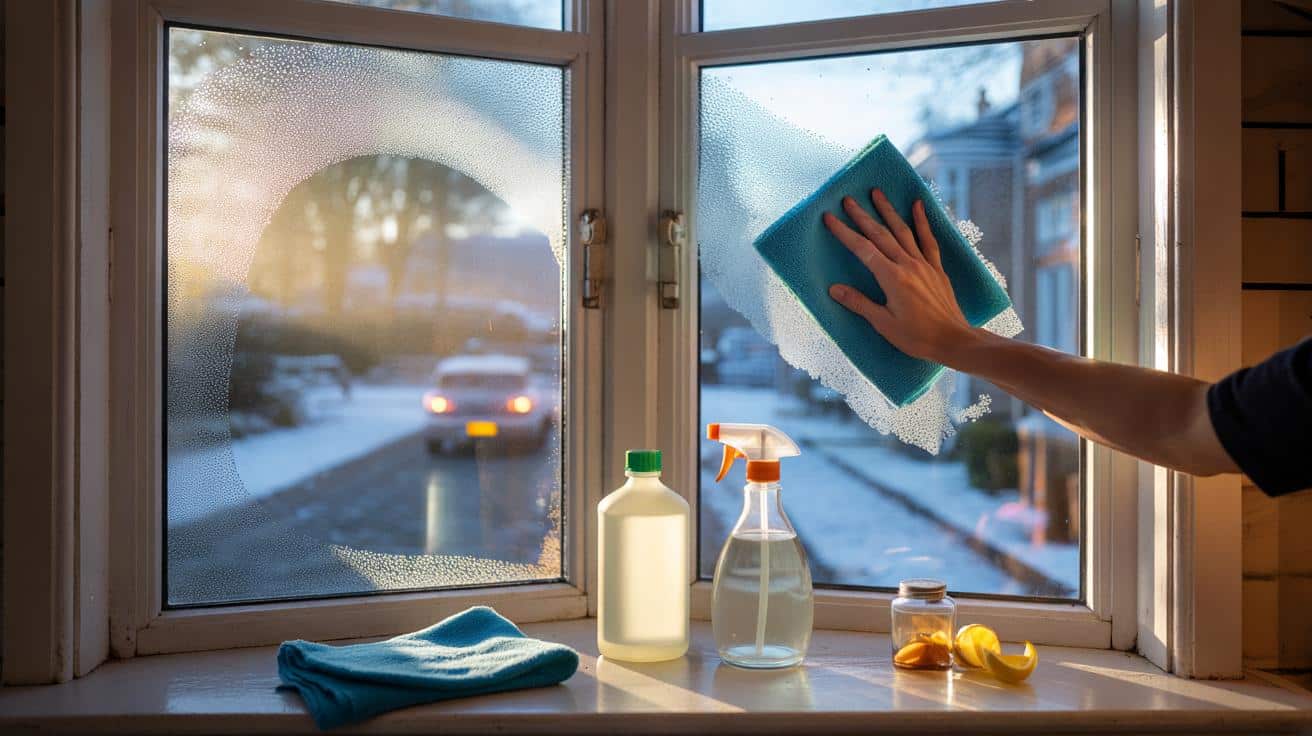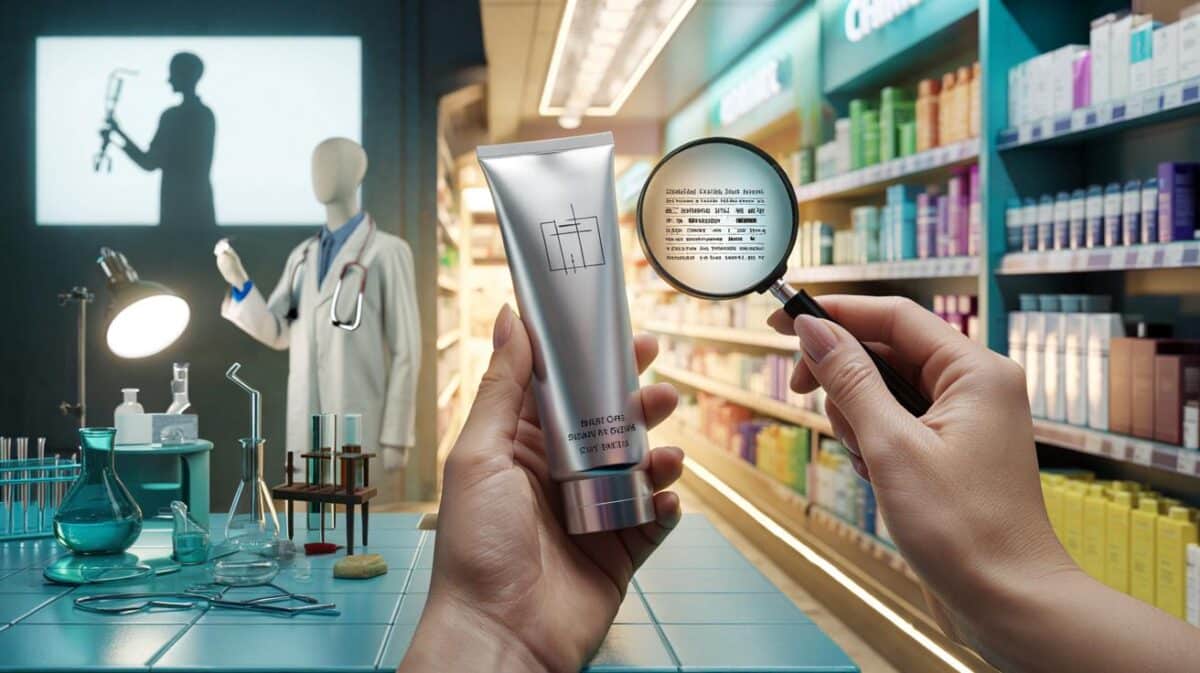Condensation crawling down the panes. A haze of traffic film that laughs at your best efforts. You wipe, you sigh, the streaks keep coming back. Winter is when glass tells the truth about our homes and cars, and most of us lose the argument. There’s a simple way to win it, though, and it’s probably already in your cupboard. Cost? About a quid. No gimmicks. No fancy kit. Just a clear view when the light is thin and everything feels a little dull.
The kettle clicked off, the house hummed, and I watched a neighbour tackle her bay window with grim determination and a roll of kitchen paper. She wiped in circles, stepped back, frowned. The low sun threw every smear into sharp relief. I’d been there last week, nudging a buggy past gritted pavements, squinting through a windswept windscreen that looked clean until the first headlight hit it. Then I remembered the bottle by the sink. I tried it. The glass changed in seconds. Almost cheeky.
The £1 kitchen staple that keeps glass honest
White vinegar is the low-cost, high-impact hero for winter glass. It doesn’t look special, and that’s the point. It strips away the filmy residue left by detergents, hard water and central heating without leaving its own trail behind. Spray, wipe, breathe, done. A plain bottle from the supermarket, often marked “distilled” or “cleaning vinegar”, quietly outperforms most pricy sprays when the sun sits low and every mark shouts at you. Best of all, it’s fast. Your window fights back less.
I tested it on a Sunday, the kind where the radiators tick and you live in hoodies. One bay window, one spritz bottle with a 1:3 mix of vinegar to warm water, two microfibre cloths. First pass lifted the dull winter film. Second pass, a buff in zigzags, and it looked like someone had tuned the brightness up. A neighbour clocked it and asked what I was using. “Vinegar,” I said. She blinked. “Like chips?” Yes, but the clear one. A bottle costs around £1 in most UK supermarkets.
Why does it work? Acetic acid. That tiny 5% concentration makes short work of alkaline grime, limescale smudges, and the invisible soap residue that loves to smear. Vinegar’s thin, so it wets the glass evenly and evaporates quickly, reducing streaks. Add a single drop of washing-up liquid to your mix and you nudge down surface tension, helping the solution glide. Pair it with a clean microfibre and a final buff using a dry cloth or old newspaper, and winter’s low-angle sunlight has nothing to catch. The science feels like magic.
How to use it like a pro (no faff required)
Mix 1 part white vinegar with 3 parts warm water in a spray bottle. If your glass is grimier than average, go 1:2 for the first clean. Add one small drop of washing-up liquid, shake slowly, and you’ve got your winter-ready solution. Spray lightly, then wipe in overlapping S-shapes from top to bottom with a clean, good-quality microfibre. Finish with a dry cloth or newspaper to polish. For car windscreens, spray onto the cloth first, not the glass, to keep it off the dashboard and trim.
Go gentle on frames and sills. Vinegar can dull natural stone and unfinished timber, so keep your cloth under control and dry those edges quickly. Clean when the glass is cool and the sun isn’t beaming through, or you’ll chase fast-drying streaks. Skip kitchen roll; it sheds fibres that stick and smear. Use two cloths—one to clean, one to buff—and swap them the second they feel damp or dirty. Let’s be honest: nobody really does that every day. Still, two fresh cloths turn hard work into quick work.
We’ve all had that moment when the low sun hits and every streak shouts back at you. A tiny tweak—vinegar in the bottle, S-shape in the wrist—changes the mood of a room and the way a commute feels in the dark months.
“In winter, clarity is a gift. Keep it simple—clean solution, clean cloth, clean finish,” says a veteran window cleaner I once shadowed on a frosty morning.
- Use white vinegar only—clear, distilled, no malt, no balsamic.
- Ratio: start 1:3 (vinegar:water). Tough film? Try 1:2 for a first pass.
- Cloths: one damp microfibre to clean, one dry to finish for a streak-free shine.
- Cars: spray the cloth, not the windscreen. Avoid contact with infotainment screens and sensors.
- Smell hack: steep citrus peels in vinegar for a week, strain, then dilute. Fresh, not chip-shop.
- Safety: do not mix vinegar with bleach. Different jobs, different bottles.
Why vinegar wins in winter—and where to draw the line
Winter glass collects more than dust. Central heating dries the air, which lifts fine particles that settle as haze. Road grit and diesel film cling to car glass. Indoors, steam from kettles and showers drifts, then cools and sticks. White vinegar cuts straight through that mix without adding its own residue, so less polishing, fewer do-overs. My nan swore by this trick, and I still hear her voice every time the spray bottle hisses. It won’t stop condensation, but it helps you see past it.
Vinegar isn’t for everything. Skip it on natural stone sills, marble ledges, or anything sealed with wax. If your windows have aftermarket tint films, test a tiny corner with a vinegar-damp cloth and wait a minute. If you notice any tackiness or colour shift, stop. For double-glazed units, keep liquid away from the spacer bar and seals. On mirrors, spray the cloth, not the glass, to keep vinegar from slipping behind the edge and clouding the backing. Common sense, light touch, good cloths. Job done.
If you’re chasing fog on bathroom mirrors or steamed-up glass in the kitchen, a quick vinegar clean can reduce the film that fog clings to, so the mist clears faster. Not magic. Just better physics in your favour. It also makes commercial anti-fog products work harder if you use them afterwards. On the car, a clean, vinegar-wiped windscreen paired with fresh wipers is the difference between squinting and seeing. For ice mornings, de-ice first with proper scraper or de-icer, then clean—vinegar isn’t antifreeze and shouldn’t pretend to be.
Take the clear view with you
There’s something oddly uplifting about glass that disappears. Rooms feel lighter, streets look kinder, and driving is less of a squint. The trick is delightfully ordinary: a bottle that costs about a quid and a couple of cloths that actually do the work. Keep a small spray by the sink, another in the boot, and bring them out when the light turns yellow and the day slows. Tiny ritual, tiny cost, big difference. Share it with the neighbour who’s still battling the streaks.
| Key points | Detail | Reader Interest |
|---|---|---|
| £1 staple | Distilled white vinegar cleans glass fast and cheap | Saves money vs brand-name sprays |
| Simple method | 1:3 vinegar:water, S-shape wipe, dry buff | Actionable steps for instant results |
| Smart limits | Avoid stone, tints; never mix with bleach | Confidence with safety and care notes |
FAQ :
- Can I use brown malt vinegar on windows?No. Use clear, distilled white vinegar only. Brown vinegars stain and smell stronger.
- What’s the best ratio for very dirty winter glass?Start at 1:3 (vinegar to water). For heavy film or hard-water haze, try 1:2 for a first clean, then switch back to 1:3.
- Will vinegar damage window seals or uPVC frames?No for quick, careful cleaning. Keep liquid off seals where possible and dry the edges. Don’t soak gaskets or leave puddles to sit.
- Is it safe on car windscreens and interior glass?Yes. Spray onto the cloth, not directly on the glass, and avoid contact with infotainment screens or sensors. Don’t use on aftermarket tint films without a spot test.
- How do I get rid of the vinegar smell?It fades as the glass dries. For a fresher scent, infuse vinegar with citrus peels for a week, then dilute; or open a window for a minute after cleaning.








